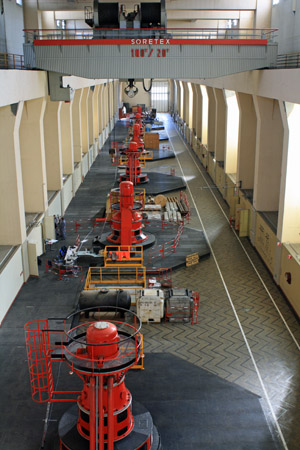 |
Châteauneuf-du-Rhône Project
Size: 295 MW |
Châteauneuf-du-Rhône hydropower plant is located on the Rhône River about 150 kilometres downstream of Lyon. Each of its Kaplan turbines has a 3-bay intake. In an effort to improve the knowledge of the flow rates passing through its turbines, CNR performed absolute flow measurement tests with the Acoustic Scintillation Flow Meter (ASFM) in the intake of Unit 5 and with the acoustic Doppler current profiler (ADCP) just downstream of the plant.
For the ADCP measurement it was not possible to operate turbine Unit 5 alone since the minimal flow rate of the Rhône is higher than the Unit 5 maximum flow rate. It was therefore necessary to measure the total flow rate downstream of the plant first with Unit 5 stopped, then with Unit 5 in operation. The difference between the two measurements permitted obtaining the variations attributable to Unit 5 alone. Considering the limited measurement accuracy achievable with the ADCP, the overall measurement difference between the ASFM and ADCP results of less than 3% was considered good. CNR thus considers the ASFM accuracy validated and plans to use it for further flow measurements at its other plants.
Publication presented at Hydro 2010 |
 |
Vaugris Project
Size: 72 MW |
The Vaugris hydropower plant is located on the Rhône river about fifty kilometers downstream of Lyon. It is equipped with four 18 MW bulb turbines of 6.25 meters runner diameter. The maximum discharge of each unit is about 350 m3/s.
As part of a study of factors negatively affecting low-head turbine performance, CNR investigated the velocity fields upstream of the Vaugris turbines. Three absolute flow measurement methods were used to verify how stable the discharge remained during comparative tests: current meters, Acoustic Scintillation Flow Meter (ASFM) and acoustic Doppler current profiler.
The flow values obtained by the ASFM were very close to the absolute flow rate values measured by current metres, except for low discharges. Taking into account the uncertainty of each measurement, the mean difference of less than 2.4% for medium and high discharges (Q >225 m3/s) was considered good.
Publication presented at Hydro 2012 |


